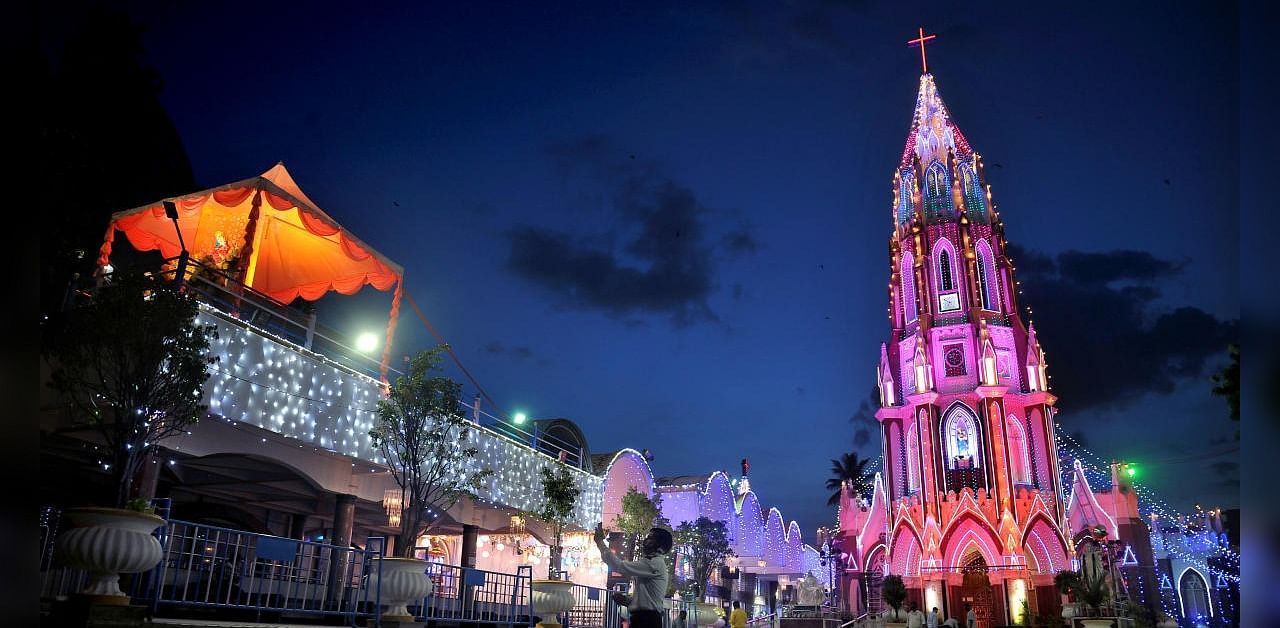
The year is 1898, and Bangalore is hit by the deadly plague, which leaves thousands dead. When it spread through Blackpalli (now Shivjinagar), people of all faiths – Hindus, Muslims and Christians – gathered inside a small Catholic church and prayed at the shrine of Mother Mary for deliverance and healing from the plague. After people were cured of the disease, it was decided to name the church ‘Annai Arokiamarie’ (Our Lady of Good Health).
Since then devotees of all faiths, even those from outside Bengaluru, have been coming to pray at the church. Recognising the deep devotion of the people of all faiths to Our Lady of Good Health, the church was raised to the status of ‘Minor Basilica’ in 1973 by Pope Paul VI.
One of the oldest churches of Bengaluru, St. Mary’s Basilica’s origins predate the plague, going back to the era of Hyder Ali and Tipu Sultan.
During the Covid-19 pandemic, though the church is locked, the shrine of Mother Mary outside the church is kept open. “So many people passing by, stand at the gate and look into the shrine and pray. A few people come in, light a candle, kneel and pray,” reveals Fr. Martin Kumar, the parish priest of the church.
Blackpalli was a barren area, almost a desert in the seventeenth century. At the time, some people, mostly farmers, came in from Ginjee in Tamil Nadu and built a small village, around which gradually a mud wall was built. Its name then was a corruption of ‘Billiakkipally’ (white bird village), the village’s name then, because it is said that the rice they cultivated was white and a lot of white birds were found in those rice fields.
A souvenir brought out by the church in 1974 notes that until 1830, some parts of the mud wall still existed. To the west of the wall, the Hindus built a small temple to Hanumantharaya; to the east, another temple was built dedicated to Someshwara. Between these two, the Christians built a small chapel with a thatched roof facing the east, naming it Kanikaimatha Devalaya (Church of Our Lady of Presentation).
Christianity in Mysuru
Christianity first entered Srirangapatna in 1648, then the capital of Mysore province. Bangalore was still a small city then and it was during the tenure of Hyder Ali (1724-25) that the city got its first church, Drummers Chapel in the Kalasipalya area. When Tipu Sultan ascended the throne, Christian missionaries had to flee Mysore and hence the history of Christianity was murky until 1799, when the British seized Srirangapatna from Tipu.
Church records show that in 1803, when there were around 1,000 Christians in the parish, A french missionary, Fr. Dubois had built a chapel with a thatched roof which was then called Kaanike Mathe Devalaya (Church of Our Lady of Presentation). Over the years, new features such as a dome or extending the nave or the wings of the church were added.
Alarmingly, in 1832, due to communal riots, the church was pulled down and pillaged, with the parish priest narrowly escaping death. Troops had to be brought in to restore peace and guard the church for months.
It was only in June 1875, that the church in its present form was constructed and was solemnly consecrated on September 8, 1882 in the presence of 35 priests and 4,000 catholics of Bangalore. Even then, due to the historical importance of the church, the British authorities in Delhi were paying a grant every year for its maintenance, until 1948.
Built in the form of a Cross, the Gothic style church is an architectural marvel with its stately arches, ornamental motifs and stained-glass windows. The imposing and magnificent tower forming the façade of the church is 160 feet high. From a small village shrine to a chapel to a church to a basilica, this colonial church is not only a major shrine of worship for all faiths, it also has a curious link with Bangalore’s history down the centuries. Equally, it is symbolic of the rejuvenation of Christianity in Mysore State following the death of Tipu Sultan.